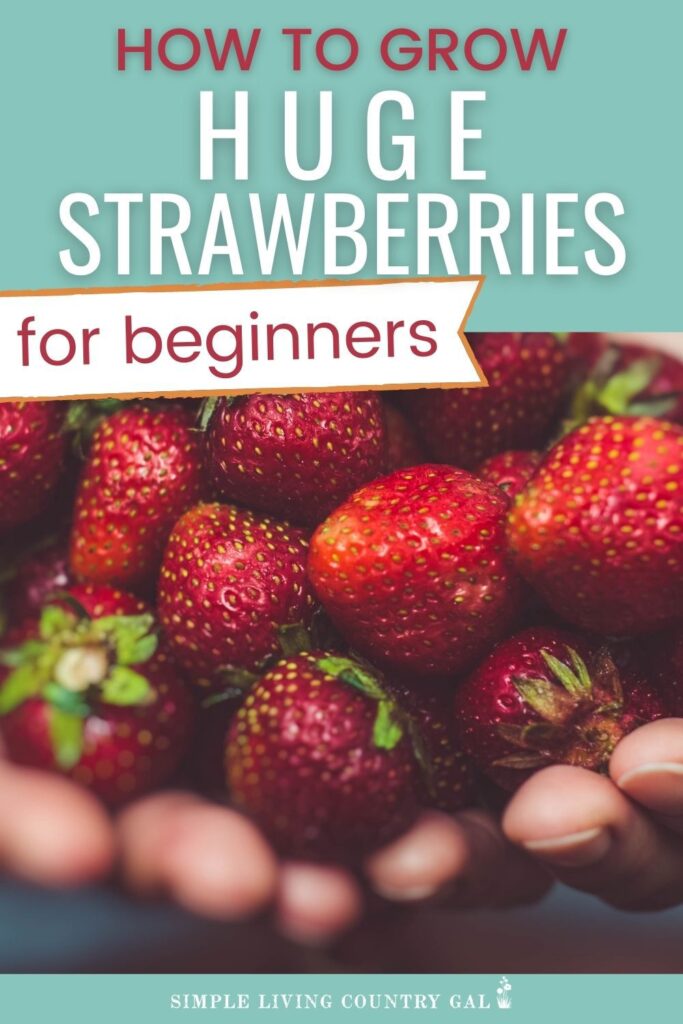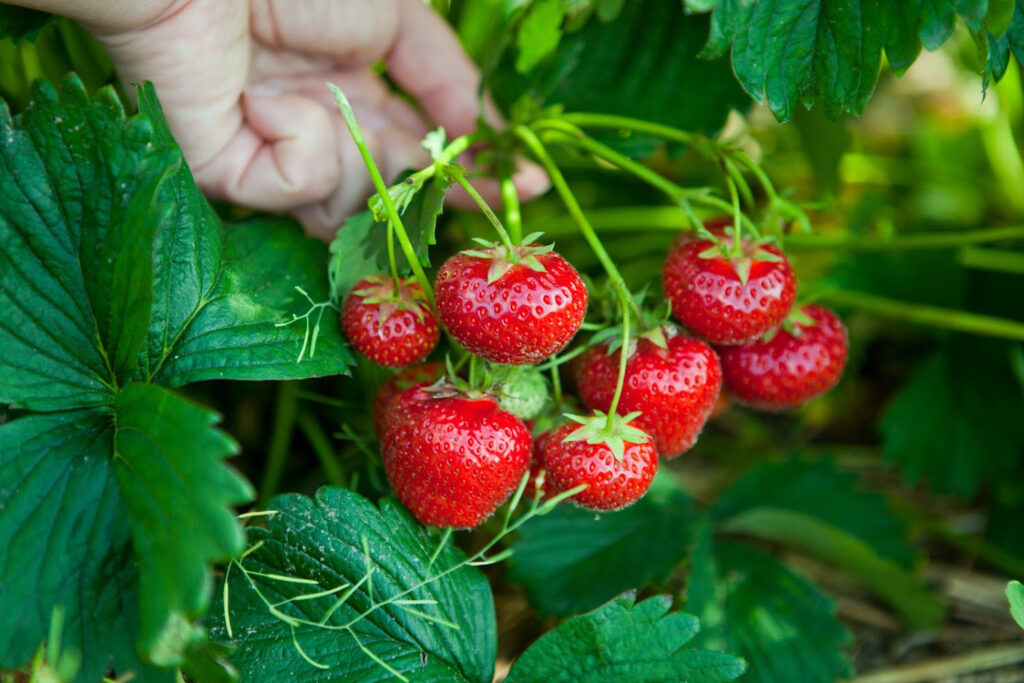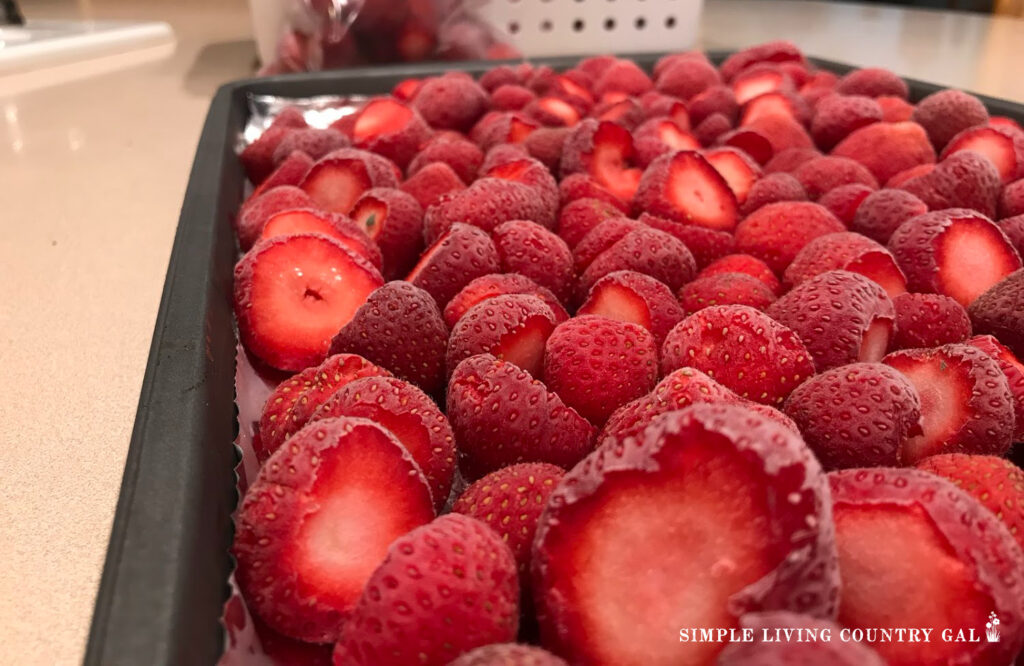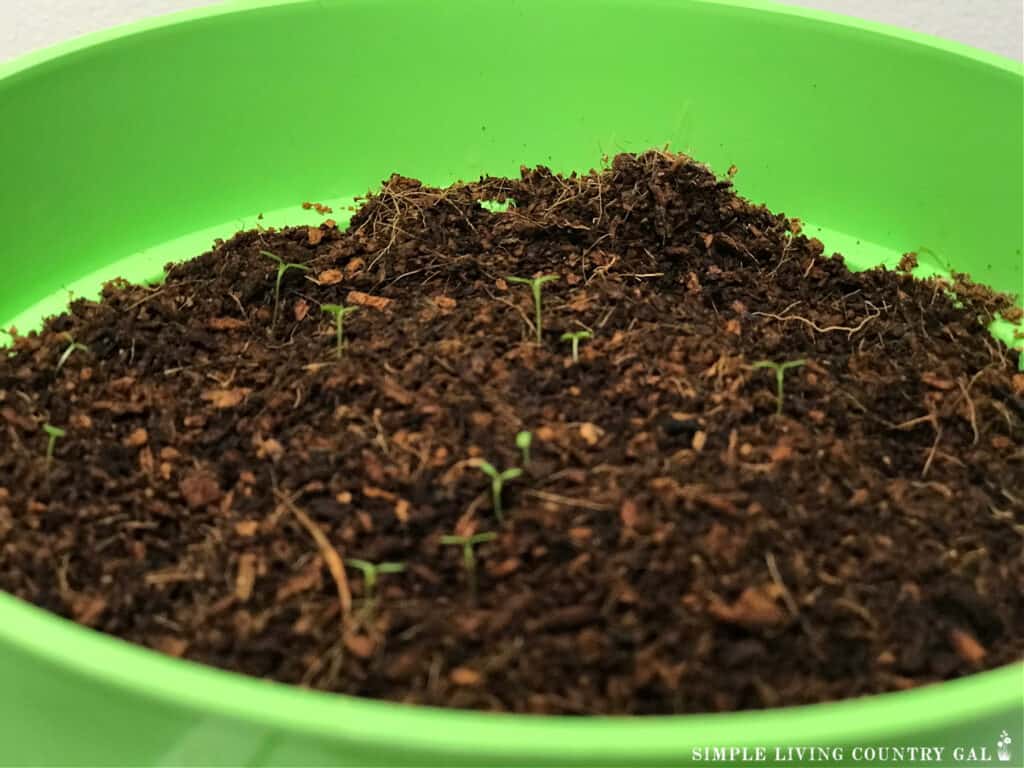How to Grow Strawberries for Beginners
If you are looking to add this amazing summer fruit to your backyard garden, then How to Grow Strawberries for Beginners is a great place to start. Learn about planting, growing, and what to watch for so you can fill your freezer and fridge full of this wonderful fruit.
Take your gardening 101 to the next level with this helpful guide.

I just love strawberries in just about any form. Jam, strawberry pretzel salad, strawberry shortcake, even strawberry daiquiris! Haha, if it has strawberries in it, I am first in line to get a helping to enjoy.
When my kids were younger we would kick off every summer by going berry picking at the local “pick your own” fields that sprinkle our rural area. Unfortunately over the last 10 years or so those fields have slowly disappeared.

That meant that our family and many of our neighbors needed to start a patch of our own. My first attempt at growing berries was a total and complete failure. My plants were small and tiny and the few berries that did grow were just enough for our local wild rabbit population that got to those little berries long before we could.
Usually when I decide to grow anything new I have a tendency to just toss it in the ground and see what happens. But this can be a costly approach to gardening and one I do not want you to adopt.
And that might be why you are here. To find out just what you need to do before, during, and after you plant your first berries in the ground. The dos and don’ts of berry growing that you can use to (fingers crossed tight) ensure you have a more successful first attempt with your own berry patch.
Spring is the perfect time to think about growing strawberries. They just love the warm full sunlight along with the warmer weather. Berries are so wonderful and adapt to grow both in your yard or in a container right there on your front or back porch. Not only do strawberries smell wonderful, but juicy ripe berries are perfect for some of your favorite summer recipes.
Another reason why we love strawberries is that they are also full of wonderful health benefits that can keep you and your family feeling great without hardly trying.
Here are just a few of the health benefits of growing strawberries:
- Help prevent strokes
- Keep arthritis at bay
- Help relieve spring and summer allergy symptoms
- Keep your immune system strong with Vitamin C and antioxidants
- Good for eye health
- Keep your skin looking young
- Help regulate blood sugar levels
- Help you lose weight by keeping you feeling full and reducing cravings
- Natural mood booster
- Help prevent cancer
I bet there is at least one benefit on that list that interests you and maybe seeing the rest of that list will help you decide that you need to eat more strawberries in your summertime. The best way to do that is to grow them yourself. Not only will this give you berries right outside your back door but it will ensure you have food that you know for sure just exactly what went into growing them. Being the grower allows you to fill your kitchen with organically grown berries that you are able to pick at the peak of ripeness.
What to Know About Growing Strawberries
There are a few things you may want to know and understand before you choose your strawberry seedlings.
different varieties of strawberries:
June Bearing – This variety produces one very large crop per year. They usually bear fruit for harvesting in June, hence the name, but they may be ready to harvest a little earlier or later depending on where you live.
Everbearing – This variety produces a more modest crop but it can start producing fruit as soon as it’s receiving 12 hours of daylight and it will continue bearing fruit all summer.
Day-neutral – With three peak periods of fruiting, this variety will keep you harvesting all summer. They usually start in early June, fruit again in mid-July, and again in late August so the crop is spread out throughout the summer.
Other Types of Strawberries
Along with varieties of strawberries, there are also different types of strawberry plants to consider:
· Albion plants are resistant to disease and produce large, firm fruits over numerous runners (Day Neutral)
· Tillamook are resistant to some diseases and produce fruit that is good for preserves or just plain eating (Early)
· Elsanta are not resistant to some diseases but do produce large, sweet fruit (Day Neutral)
· Jewel are resistant to some leaf diseases and produce large, firm fruit (Everbearing)
· Northeaster produces large berries with a high yield (Early)
· Quinalt are resistant to many diseases and produce large, soft fruit (Everbearing)
· Earliglow are resistant to leaf and root diseases and produce very flavorful strawberries (Early)
Choose a variety and type based on your growing zone and season as well as the type of harvest you’d like to produce.
Strawberries are a perennial and will need plenty of full sunlight to produce the best fruit; at least 10 hours of sunlight with at least 6 hours of direct sunlight each day. For planting, you’ll need to plan space where you can plant 12-18 inches apart. Strawberries are self-fertile and you can grow indoors, but you’ll get a better fruit and better harvest outdoors where they can be pollinated by bees.
Strawberries grow on runners, vines that produce several plants. Too many runners will take over your yard and stifle plant growth so you’ll want to remove some throughout the season. One runner of a Jun Bearing plant can produce up to 120 daughters (plants).
What You Need to Grow Strawberries
Whether you’re planting in your yard or in a container, there are a few things you will need to successfully grow strawberries. First and foremost, you’ll need good soil. Strawberries prefer slightly acidic soil with a pH between 5.5 and 6.8. Before planting in your yard, do a soil test to determine if you need to add more nutrients and choose an organic, nutrient-rich soil to supplement your own or to plant in a container. Be sure to use soil and containers that allow for plenty of drainage so your roots don’t rot.
Strawberries also need plenty of sunlight. On average, 10 hours a day with at least 6 of those being in direct light, but don’t exceed 14 hours of light in a day. Before planting, watch the sun pattern in various areas of your yard to determine where your strawberries will get the best light. This may even determine if you plant in the ground or in a container.
Strawberry plants like to spread out so you’ll also need plenty of space or a few containers. Plan on about 18 inches for each plant. You can control the spread by clipping some of the runners, but you’ll want to be careful about clipping too much as it can deplete your harvest.
Temperature
Growing strawberries in warmer temperatures is ideal; preferably 60°-80°F. If you live in a warmer climate, you may be able to grow strawberries all year long. If your temperatures reach higher temperatures during the mid-Summer consider using a shade cloth part of the day to keep the flowers from burning and drying out.
You can also place a layer of straw over the growing bed to help protect the leaves. When using straw, be sure to let it dry out before watering again.
Sun
As previously mentioned, strawberries love sunlight. A lot of it! In more comfortable temperatures of up to 80°F, you’ll want to find the sunniest spot in your yard. Direct sunlight should be a minimum of 6 hours per day with about 10 hours of day of natural light, no more than 14 hours.
The long daylight hours and warmer temperatures of spring and summer make the seasons perfect for planting strawberries. If temperatures get too though, you’ll need to plan some shade protection for your plants to keep them from burning. Strawberry flowers are delicate and will burn easily.
Soil
The perfect soil pH for growing strawberries is 5.5 to 6.8. To ensure your plants will produce the best results, do a soil test before planting. If planting in a container or raised bed, use an organic, nutrient-rich premium potting soil. You can easily give your soil a boost by mixing it with several inches of aged compost or other nutrient-rich organic matter.
Watering
While strawberries do need a sufficient amount of water to blossom and grow, overwatering can cause rot. Aim for 1 to 1.5 inches of water a week doing your best to avoid wetting the leaves. Straw or black plastic can help to keep the soil moist and the fruit clean.
READ: How to Water Your Plants to Prevent Diseases
Fertilizing
Continuous release fertilizer can help keep your strawberry plants healthy and thriving; all-purpose granules are a good option for strong growth. In warm weather, you can expect your berries to ripen about 30 days after the blossoms have been fertilized.
How Many Strawberry Plants Do You Need to Plant?
Because strawberry plants produce a significant number of blooms and continue to grow, you should only need to plant two plants per person. If you plan to make jams or freeze some of your harvest, you may want to plant a few more.
READ: HOW TO FREEZE STRAWBERRIES
When to Plant Strawberries
The best time for planting is late March into early April, after the last frost of the season. This will allow plenty of time for the plants to take root, blossom, and produce a harvest by late spring.

How to Plant Strawberries
There are two ways to plant strawberries; seed or seedlings/runners from another plant. If you know someone who is growing strawberries, ask them for some runners. They’ll need to pull some anyway to keep their current plants growing strong. You can plant these runners, fertilize and water them, and allow them some time to take root. They’ll produce beautiful strawberry plants. Or, if you’d prefer, like many other plants you can grow strawberries from seeds.
If growing from seeds, you’ll want to refrigerate your seeds for 3-4 weeks before planting. This will help them germinate and grow faster as they require cold stratification to germinate.
When planting, dig holes deep and wide enough to house the entire root system without bending. Don’t go too deep though, the root should be covered but the crown should be at the surface. The crown (the central growing bud) should not be buried or it could rot. Leaves, flowers, and fruit will all need to be exposed to light and fresh air for healthy growth.
Water the plants well after planting to help them settle into the soil. Keep the beds mulched to reduce weeds and help them stay hydrated without overwatering.
How to Grow Strawberries In Containers
With all of this talk about how much space strawberries need to grow, you may not think you can grow them in pots or containers, but you can. Let’s take a look at some of the options.

Hanging Baskets
You can easily grow strawberries in a hanging basket. Line the basket with moss for drainage, then plant a few plants in there. Since the strawberry vines will grow down over the basket’s edges, you can fit 2-3 plants in a basket without any trouble. You can also use grow bags or strawberry planters and plant a single strawberry plant in each pocket.
Pots
Growing strawberries in pots is both pretty and tasty. You can place the pots on your deck or patio and enjoy the strawberry blossoms then enjoy the delicious berries when they grow. Stackable, tiered pots like these are a great way to grow strawberries in a small space.
Containers make it easy to grow delicious strawberries without too much work in the garden and containers provide their own drainage system to help you avoid root rot and disease. And, if you don’t get sun for 6-10 hours a day in one spot, you can easily move your containers to follow the sun.
READ: How to Grow Vegetables in the Suburbs and the City
How Long Does It Take Strawberries to Grow?
Strawberries usually grow in about 2 months from runner or up to 6 months from seeds, depending on the environment. You can start harvesting as soon as you see full, ripe fruit. Don’t leave fruit on the vine too long as it can rot or mold before you have a chance to enjoy it. Plan to harvest 4-6 weeks after blossoming. Cut the fruit by the stem, don’t pull it or you could damage the runner.
Things to Watch for When Growing Strawberries
Strawberry plants are incredibly susceptible to slugs. Scattering broken eggshells around the plant will help deter them. The tarnished plant bug can also be a problem. It’s a small flat insect with wings. Pick off any you see or spray with insecticidal soap. The bud weevil can also be a problem; they’ll pierce new buds keeping the fruit from growing. Getting rid of any infected buds you see will help.
Root rot can also be a problem if the plants are overwatered. Prevent this by using well-draining soil and only water 1-2 inches per week, keeping the water away from the leaves. Keep berries off the ground as much as possible with straw or black plastic to prevent mold and keep fruits from touching dead leaves. If you find dead leaves, remove them.
What not to Plant Next to Strawberries
There are certain plants you will not want to have near your berries as they are growing. Some will shade your plants, some will deplete the soil of nutrients your strawberries need to grow, and finally, some will change the pH of the soil. By keeping good companions near your berry patch you will grow a healthy crop that is full of amazing berries. What not to plant near strawberries.
Additional Planting Notes
· Keeping beds weed-free and using gritty mulch will help deter bugs and slugs. Sand works well to deter slugs.
· Spray plants with pureed garlic and neem seed oil if you see Japanese beetles.
· At the end of the season, cut foliage down to one inch and mulch plants about 4 inches deep to protect them over the winter. You can remove the mulch in early spring after the last frost.
Strawberries are both healthy and delicious and their flowers make a lovely addition to any garden, patio, or deck when they bloom. And since they produce so much fruit, your family can enjoy plenty of strawberry dishes over the summer months. Fresh strawberry shortcake, strawberry lemonade, and homemade strawberry jam, just to name a few. You’ll love them in salads and right out of the colander after they’ve been rinsed. It may be time to think about adding fresh strawberries to your garden for the summer.
Now that you have the basics on how to grow strawberries in your own backyard, you can add another amazing fruit to your kitchen freezer.


What a timely post – I’m planting strawberries today! Thanks for all the helpful tips, Tracy Lynn!
Thanks for all of the great tips. Hopefully, next summer will yield more now that I know what I am doing.
I am glad you found it helpful! Good luck!
Tracy Lynn